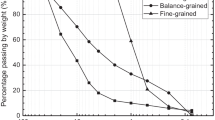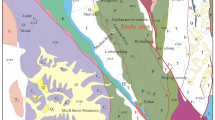Abstract
Landslide dams formed by successive rock slides in the same location may cause severe and long-term destruction to affected areas. However, studies on the formation of landslide dams that result from successive rock slides are still at early stages. In this paper, a flume test that could model rock fragmentation and the flow of fragmentary material is used to study the formation of landslide dams triggered by successive long-runout rock slides. The tests assess the effects of number of blocks, the number of times the blocks are released, and the initial arrangement of blocks before release on the dam geometry. The maximum and minimum landslide dam heights rise with the increasing number of blocks in each series of tests, while there is minimal or even no growth in the dam length for some series. Additionally, more block releases produce larger minimum dam height but smaller maximum dam height. Together, these results indicate that more releases are prone to fully block the flow channel by forming a steep dam. Furthermore, the initial block arrangement is also found to influence the landslide dam formation. In this study, landslide dams caused by successive rock slides are divided into two types: the stable type, namely, the landslide dam(s) already formed by the previous slide event(s) maintains general stability before the next slide lands on the dam surface; the unstable type, namely, the landslide dam(s) by the previous slide episode(s) has failed before the next damming slide occurs. Field investigations showed that slide episodes in both types of successive landslide dams are influential for the dam formation and river morphology.












Similar content being viewed by others
References
Bonnard C (2006) Technical and human aspects of historic rockslide dammed lakes and landslide dam breaches. Ital J Eng Geol Environ (Special Issue 1):21–30
Bowman ET, Take WA, Rait KL, Hann C (2012) Physical models of rock avalanche spreading behaviour with dynamic fragmentation. Can Geotech J 49(4):460–476
Burchsted D, Daniels MD (2014) Classification of the alterations of beaver dams to headwater streams in northeastern Connecticut, USA. Geomorphology 205:36–50
Chai HJ, Liu HC, Zhang ZY (1996) The main conditions of landslide dam. J Geol Hazards Environ Preserv 7(1):41–46 (in Chinese)
Chai HJ, Liu HC, Zhang ZY (2000) The temporal-spatial distribution of damming landslides in China. J Mt Res 18:51–54 (in Chinese)
Chang DS, Zhang LM (2010) Simulation of the erosion process of landslide dams due to overtopping considering variations in soil erodibility along depth. Nat Hazards Earth Syst Sci 10(4):933–946
Chen CY, Chang JM (2016) Landslide dam formation susceptibility analysis based on geomorphic features. Landslides 13(5):1019–1033
Chen TC, Lin ML, Hung JJ (2004) Pseudostatic analysis of Tsao-Ling rockslide caused by Chi-Chi earthquake. Eng Geol 71(1-2):31–47
Chen RF, Chang KJ, Angelier J, Chan YC, Deffontaines B, Lee CT, Lin ML (2006) Topographical changes revealed by high-resolution airborne LiDAR data: the 1999 Tsaoling landslide induced by the Chi–Chi earthquake. Eng Geol 88(3-4):160–172
Choi CE, Cui YF, Au KYK, Liu HM, Wang J, Liu DZ, Wang H (2018) Case study: effects of a partial-debris dam on riverbank erosion in the Parlung Tsangpo River, China. Water 10:250
Domènech G, Fan XM, Scaringi G, van Asch TW, Xu Q, Huang RQ, Hales TC (2019) Modeling the role of material depletion, grain coarsening and revegetation in debris flow occurrences after the 2008 Wenchuan earthquake. Eng Geol 250:34–44
Dong JJ, Tung YH, Chen CC, Liao JJ, Pan YW (2009) Discriminant analysis of the geomorphic characteristics and stability of landslide dams. Geomorphology 110(3-4):162–171
Dong JJ, Li YS, Kuo CY, Sung RT, Li MH, Lee CT, Chen CC, Lee WR (2011) The formation and breach of a short-lived landslide dam at Hsiaolin village, Taiwan—part I: post-event reconstruction of dam geometry. Eng Geol 123(1-2):40–59
Dunning SA, Rosser NJ, Petley DN, Massey CR (2006) Formation and failure of the Tsatichhu landslide dam, Bhutan. Landslides 3(2):107–113
Eberhardt E, Stead D, Coggan JS (2004) Numerical analysis of initiation and progressive failure in natural rock slopes—the 1991 Randa rockslide. Int J Rock Mech Min Sci 41(1):69–87
Ermini L, Casagli N (2003) Prediction of the behaviour of landslide dams using a geomorphological dimensionless index. Earth Surf Process Landf 28(1):31–47
Fan XM, Rossiter DG, Westen CJ, Xu Q, Görüm T (2014) Empirical prediction of coseismic landslide dam formation. Earth Surf Process Landf 39(14):1913–1926
Fan XM, Juang CH, Wasowski J, Huang RQ, Xu Q, Scaringi G et al (2018) What we have learned from the 2008 Wenchuan earthquake and its aftermath: a decade of research and challenges. Eng Geol 241:25–32
Fan XM, Xu Q, Alonso-Rodriguez A, Subramanian SS, Li WL, Zheng G et al (2019a) Successive landsliding and damming of the Jinsha River in eastern Tibet, China: prime investigation, early warning, and emergency response. Landslides 16(5):1003–1020
Fan XM, Scaringi G, Korup O, West AJ, van Westen CJ, Tanyas H et al (2019b) Earthquakesten CJ, Tanyas H, geologic hazards: Patterns, mechanisms, and impacts. Rev Geophys 57:421–503
Fread DL (1984) DAMBRK: the NWS dam-break flood forecasting model (Vol. 4). Hydrologic Research Laboratory, National Weather Service, NOAA
Gregoretti C, Maltauro A, Lanzoni S (2010) Laboratory experiments on the failure of coarse homogeneous sediment natural dams on a sloping bed. J Hydraul Eng 136(11):868–879
Huang RQ, Yu B, Hu W, Li WL, Fan XM, Tang C, Xu Q (2016) The long-term geologic hazards and consequent risk after the Wenchuan earthquake. In Landslides and engineered slopes. Experience, Theory and Practice: Proceedings of the 12th International Symposium on Landslides (Napoli, Italy, 12-19 June 2016), CRC Press
Hungr O, Evans SG (2004) Entrainment of debris in rock avalanches: an analysis of a long run-out mechanism. Geol Soc Am Bull 116(9-10):1240–1252
Korup O (2002) Recent research on landslide dams-a literature review with special attention to New Zealand. Prog Phys Geogr 26(2):206–235
Korup O (2004) Geomorphometric characteristics of New Zealand landslide dams. Eng Geol 73(1-2):13–35
Korup O, Tweed F (2007) Ice, moraine, and landslide dams in mountainous terrain. Quat Sci Rev 26(25-28):3406–3422
Kuo YS, Tsang YC, Chen KT, Shieh CL (2011) Analysis of landslide dam geometries. J Mt Sci 8(4):544–550
Li MH, Hsu MH, Hsieh LS, Teng WH (2002) Inundation potentials analysis for Tsao-Ling landslide lake formed by Chi-Chi earthquake in Taiwan. Nat Hazards 25(3):289–303
Li WX, Wang ZY, Wang XZ, Qi LJ, He XY (2014) Secondary mountain disaster chain induced by the Wenchuan earthquake and the result of chain-cutting engineering in the Xiaogangjian gully. J Mt Sci 32(3):336–344 (in Chinese)
Li B, Feng Z, Wang G, Wang W (2016) Processes and behaviors of block topple avalanches resulting from carbonate slope failures due to underground mining. Environ Earth Sci 75(8):694
Liu W, He SM (2016) A two-layer model for simulating landslide dam over mobile river beds. Landslides 13(3):565–576
Liu CZ, Huang XB, Li L (1995) Wu River dammed by Jiguanling landslide and relative preventive measures. Hydrogeol Eng Geol 4:6–11 (in Chinese)
Liu N, Cheng ZL, Cui P, Chen NS (2013) Dammed lake and risk management. Science Press, Beijing (in Chinese)
Manzella I, Labiouse V (2008) Qualitative analysis of rock avalanches propagation by means of physical modelling of non-constrained gravel flows. Rock Mech Rock Eng 41(1):133–151
Manzella I, Labiouse V (2010) Physical modelling to better understand rock avalanches. In: Proceedings of the 7th International Conference on Physical Modelling in Geotechnics Taylor & Francis Group 2 (EPFL-CONF-163002), pp 1259–1265
Peng M, Zhang LM (2012) Breaching parameters of landslide dams. Landslides 9(1):13–31
Sartori M, Baillifard F, Jaboyedoff M, Rouiller JD (2003) Kinematics of the 1991 Randa rockslides (Valais, Switzerland). Nat Hazards Earth Syst Sci 3(5):423–433
Schuster RL (2006) Impacts of landslide dams on mountain valley morphology. In: Landslides from massive rock slope failure. Springer, Dordrecht, pp 591–616
Shi ZM, Wang YQ, Peng M, Guan SG, Chen JF (2015) Landslide dam deformation analysis under aftershocks using large-scale shaking table tests measured by videogrammetric technique. Eng Geol 186:68–78
Tacconi Stefanelli C, Segoni S, Casagli N, Catani F (2016) Geomorphic indexing of landslide dams evolution. Eng Geol 208:1–10
Tacconi Stefanelli C, Vilímek V, Emmer A, Catani F (2018) Morphological analysis and features of the landslide dams in the Cordillera Blanca, Peru. Landslides 15(3):507–521
Tang R, Fan XM, Scaringi G, Xu Q, van Westen CJ, Ren J, Havenith HB (2019) Distinctive controls on the distribution of river-damming and non-damming landslides induced by the 2008 Wenchuan earthquake. Bull Eng Geol Environ 78(6):4075–4093
Wang ZY, Melching CS, Duan XH, Yu GA (2009) Ecological and hydraulic studies of step-pool systems. J Hydraul Eng 135(9):705–717
Wang ZY, Lee Joseph JH, Melching CS (2014) River dynamics and integrated river management. Springer Science & Business Media, Berlin
Wang F, Dai Z, Okeke CAU, Mitani Y, Yang H (2018) Experimental study to identify premonitory factors of landslide dam failures. Eng Geol 232:123–134
Xu Q, Fan XM, Huang RQ, Van Westen C (2009) Landslide dams triggered by the Wenchuan earthquake, Sichuan Province, south west China. Bull Eng Geol Environ 68(3):373–386
Xu FG, Yang XG, Zhou JW (2017) Dam-break flood risk assessment and mitigation measures for the Hongshiyan landslide-dammed lake triggered by the 2014 Ludian earthquake. Geomatics Nat Hazards Risk 8(2):803–821
Yang SH, Pan YW, Dong JJ, Yeh KC, Liao JJ (2013) A systematic approach for the assessment of flooding hazard and risk associated with a landslide dam. Nat Hazards 65(1):41–62
Zhao T, Dai F, Xu NW (2017) Coupled DEM-CFD investigation on the formation of landslide dams in narrow rivers. Landslides 14(1):189–201
Zhao GW, Jiang YJ, Qiao JP, Yang ZJ, Ding PP (2018) Numerical and experimental study on the formation mode of a landslide dam and its influence on dam breaching. Bull Eng Geol Environ. https://doi.org/10.1007/s10064-018-1255-0
Zhou JW, Cui P, Fang H (2013) Dynamic process analysis for the formation of Yangjiagou landslide-dammed lake triggered by the Wenchuan earthquake, China. Landslides 10(3):331–342
Zhou JW, Cui P, Hao MH (2016) Comprehensive analyses of the initiation and entrainment processes of the 2000 Yigong catastrophic landslide in Tibet, China. Landslides 13(1):39–54
Acknowledgments
Critical comments by the anonymous reviewers greatly improved the initial manuscript.
Funding
This study was supported by the National Key R&D Program of China (2017YFC1501100), the National Natural Science Foundation of China (41977229), and the Youth Science and Technology Fund of Sichuan Province (2016JQ0011).
Author information
Authors and Affiliations
Corresponding author
Rights and permissions
About this article
Cite this article
Liao, Hm., Yang, Xg., Lu, Gd. et al. Experimental study on the formation of landslide dams by fragmentary materials from successive rock slides. Bull Eng Geol Environ 79, 1591–1604 (2020). https://doi.org/10.1007/s10064-019-01651-7
Received:
Accepted:
Published:
Issue Date:
DOI: https://doi.org/10.1007/s10064-019-01651-7




